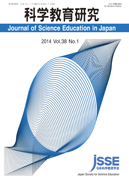31 巻, 4 号
選択された号の論文の25件中1~25を表示しています
- |<
- <
- 1
- >
- >|
-
原稿種別: 巻頭言
2007 年 31 巻 4 号 p. 193-194
発行日: 2007/12/27
公開日: 2017/06/30
PDF形式でダウンロード (246K) -
原稿種別: 研究論文
2007 年 31 巻 4 号 p. 195-209
発行日: 2007/12/27
公開日: 2017/06/30
PDF形式でダウンロード (1739K) -
原稿種別: 研究論文
2007 年 31 巻 4 号 p. 210-219
発行日: 2007/12/27
公開日: 2017/06/30
PDF形式でダウンロード (1342K) -
原稿種別: 研究論文
2007 年 31 巻 4 号 p. 220-227
発行日: 2007/12/27
公開日: 2017/06/30
PDF形式でダウンロード (1019K) -
原稿種別: 研究論文
2007 年 31 巻 4 号 p. 228-237
発行日: 2007/12/27
公開日: 2017/06/30
PDF形式でダウンロード (1172K) -
原稿種別: 実践論文
2007 年 31 巻 4 号 p. 238-247
発行日: 2007/12/27
公開日: 2017/06/30
PDF形式でダウンロード (1795K) -
原稿種別: 実践論文
2007 年 31 巻 4 号 p. 248-256
発行日: 2007/12/27
公開日: 2017/06/30
PDF形式でダウンロード (960K) -
原稿種別: 実践論文
2007 年 31 巻 4 号 p. 257-264
発行日: 2007/12/27
公開日: 2017/06/30
PDF形式でダウンロード (808K) -
原稿種別: 実践論文
2007 年 31 巻 4 号 p. 265-274
発行日: 2007/12/27
公開日: 2017/06/30
PDF形式でダウンロード (1647K) -
原稿種別: プラザ
2007 年 31 巻 4 号 p. 275-278
発行日: 2007/12/27
公開日: 2017/06/30
PDF形式でダウンロード (581K) -
原稿種別: 招待解説
2007 年 31 巻 4 号 p. 279-286
発行日: 2007/12/27
公開日: 2017/06/30
PDF形式でダウンロード (826K) -
原稿種別: 招待解説
2007 年 31 巻 4 号 p. 287-294
発行日: 2007/12/27
公開日: 2017/06/30
PDF形式でダウンロード (1020K) -
原稿種別: 招待解説
2007 年 31 巻 4 号 p. 295-300
発行日: 2007/12/27
公開日: 2017/06/30
PDF形式でダウンロード (787K) -
原稿種別: 招待解説
2007 年 31 巻 4 号 p. 301-309
発行日: 2007/12/27
公開日: 2017/06/30
PDF形式でダウンロード (1460K) -
原稿種別: 招待論文
2007 年 31 巻 4 号 p. 310-318
発行日: 2007/12/27
公開日: 2017/06/30
PDF形式でダウンロード (1208K) -
原稿種別: 総説・展望
2007 年 31 巻 4 号 p. 319-327
発行日: 2007/12/27
公開日: 2017/06/30
PDF形式でダウンロード (1148K) -
原稿種別: 研究論文
2007 年 31 巻 4 号 p. 328-339
発行日: 2007/12/27
公開日: 2017/06/30
PDF形式でダウンロード (1590K) -
原稿種別: 研究論文
2007 年 31 巻 4 号 p. 340-353
発行日: 2007/12/27
公開日: 2017/06/30
PDF形式でダウンロード (1470K) -
原稿種別: 研究論文
2007 年 31 巻 4 号 p. 354-369
発行日: 2007/12/27
公開日: 2017/06/30
PDF形式でダウンロード (2041K) -
原稿種別: 研究論文
2007 年 31 巻 4 号 p. 370-379
発行日: 2007/12/27
公開日: 2017/06/30
PDF形式でダウンロード (1198K) -
原稿種別: 研究論文
2007 年 31 巻 4 号 p. 380-390
発行日: 2007/12/27
公開日: 2017/06/30
PDF形式でダウンロード (1311K) -
原稿種別: 研究論文
2007 年 31 巻 4 号 p. 391-399
発行日: 2007/12/27
公開日: 2017/06/30
PDF形式でダウンロード (1145K) -
原稿種別: 研究論文
2007 年 31 巻 4 号 p. 400-409
発行日: 2007/12/27
公開日: 2017/06/30
PDF形式でダウンロード (1172K) -
原稿種別: 実践論文
2007 年 31 巻 4 号 p. 410-420
発行日: 2007/12/27
公開日: 2017/06/30
PDF形式でダウンロード (1388K) -
原稿種別: 資料
2007 年 31 巻 4 号 p. 421-431
発行日: 2007/12/27
公開日: 2017/06/30
PDF形式でダウンロード (1411K)
- |<
- <
- 1
- >
- >|
